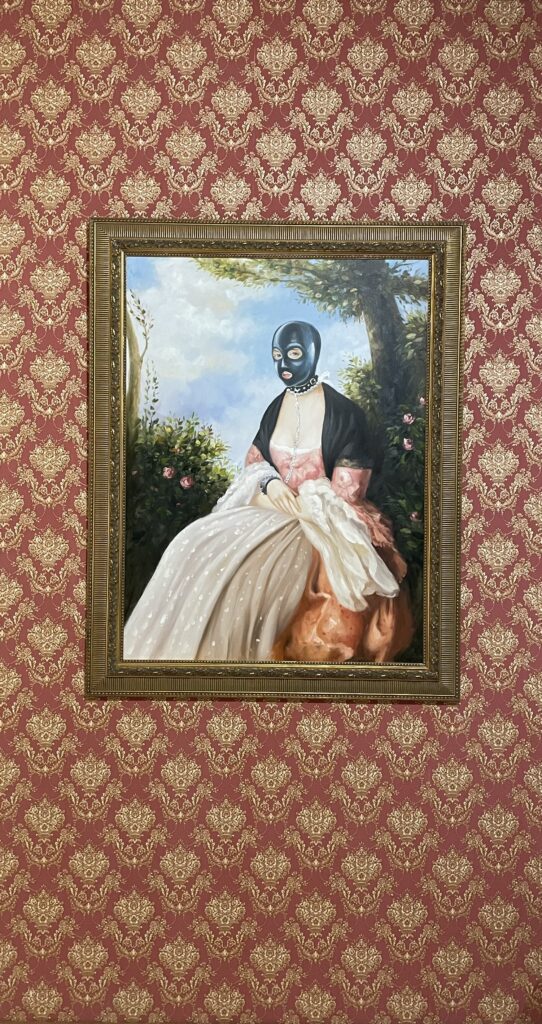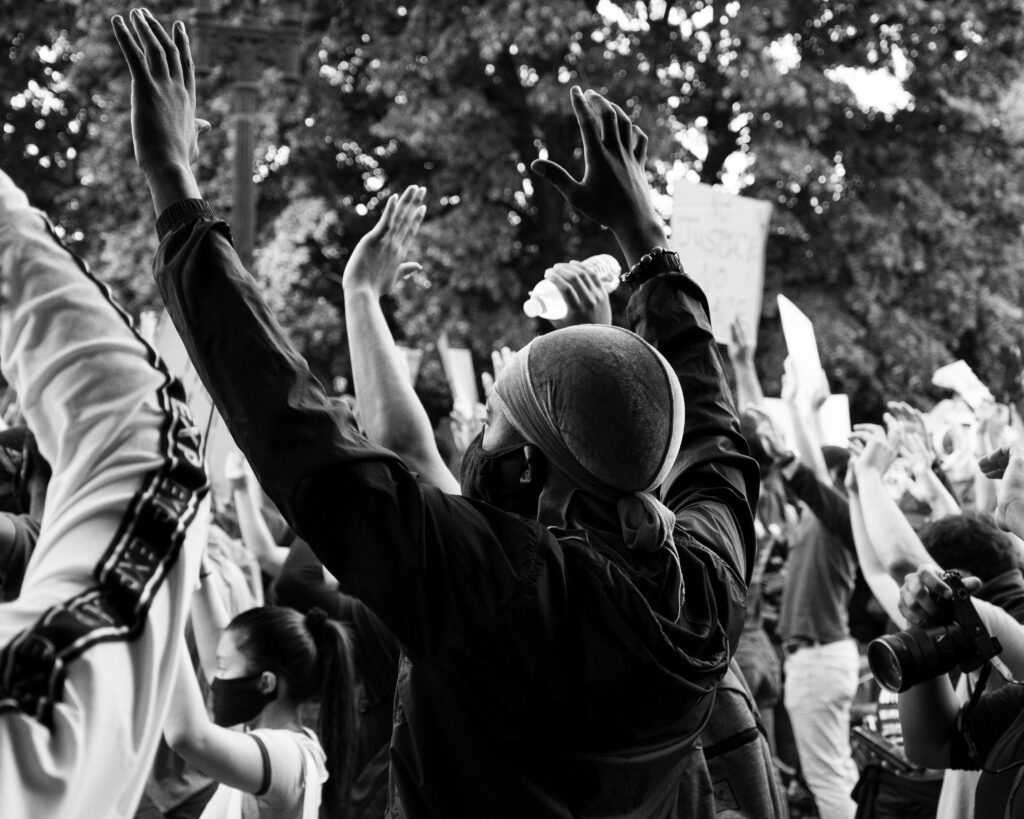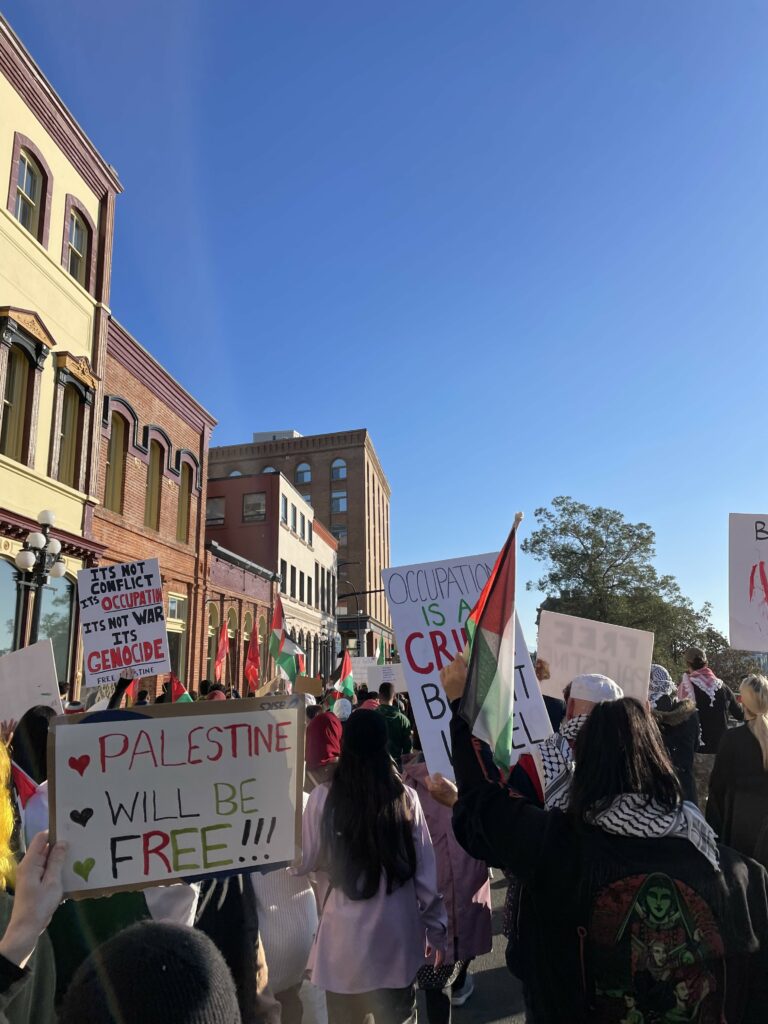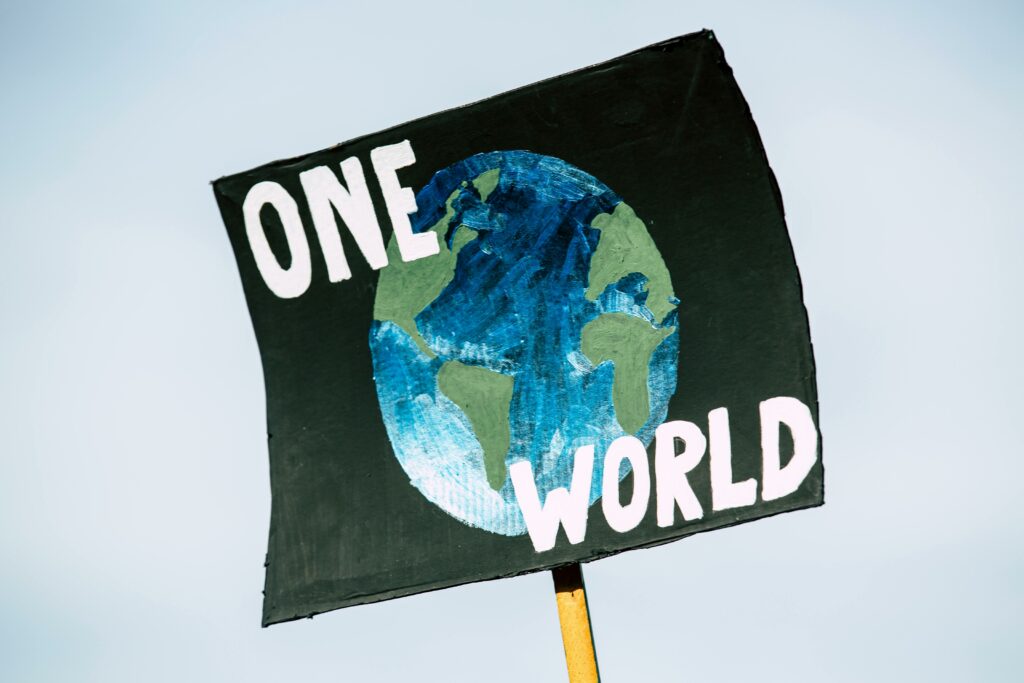Dallia Knight
Published open December 13, 2024

One would assume that politics has no place in the fashion industry, but this is simply not the case. The personal is political, and fashion is certainly personal. Since the beginning of intentional dressing, what we wear has been in conversation with our positionality in the world. I will explore the ways in which fashion has evolved to be a powerful tool for self-expression, reflecting the socio-political environment of its time. Fashion activism first gained traction through the use of clothing as visual symbols of resistance.
The sans-culotte was a movement inspired by the rejection of knee-length undergarments that were associated with nobility. Instead, the working class people opted for ankle-length britches to symbolize their association with the ideas of the French Revolution in the late 17th century. While a majority of the sans-culotte people were not actively associated with organized political demonstrations, those who did participate often used mob intimation to create an economy that prioritized the communal distribution of wealth and human essentials such as food and suffrage. By wearing long britches, working class citizens displayed their solidarity and the critiques of elitist authority. The sans-culotte movement led to many changes in the political state and ultimately the overthrowing of the French Monarchy. This was a revolt against systemic inequality based on class and social status but there are many intersectional to resist authority.
The Black Panther Party for Self Defence was founded in 1966 with the aim to police African American neighborhoods as a form of resistance against police brutality. Their mission eventually expanded to include community and education programs, such as the Free Breakfast For School Children Program. In 1969, The BPP implemented this program in an attempt to curb the issue of food scarcity in low income neighborhoods by providing thousands of impoverished youth meals before school. The success of this program put pressure on the US federal government to expand their own initiatives and create a permanent School Breakfast Program (SBP) in 1975. Grassroots efforts by black activists were crucial for the creation of programs such as the SBP which undoubtedly influence public policies and highlight the need for solutions to systemic food scarcity amongst Americans.

Koshu Kunii on Unspalsh
The Black Panther Party adopted the uniform of “an afro tucked into a black beret, sunglasses over the eyes, a black leather jacket ornamented with pinback buttons, and a gun strapped across the body with a fist in the air”. The black jacket, beret and sunglasses served to limit the visible identities of members as well as showcase the uniformity of the party’s members. This now iconic outfit was in direct opposition to what was viewed as acceptable attire for African Americans and became synonymous with Black Power and the resistance of predominantly white exploitation of power. The Black Panthers encouragement of natural African hairstyles such as the afro was a form of body politics as it directly defied the standard of what was viewed as professional or respectable. In doing so, it also validated the experiences of African Americans who had been pressured to conform to Eurocentric beauty standards and empowered the notion that ‘Black Is Beautiful’. The leaders of the BPP, Huey P. Newton and Bobby Seale, were inspired to adopt the beret after seeing French Resistance fighters sporting them during World War II. The beret was later recognized as a marker of revolution as proven by high ranking politicians such as Cuba’s Fidel Castro. The militant tone of the beret as part of the BPP’s uniform conveyed a sense of discipline within the BPP’s members and cemented their position as soldiers fighting on the front line against racial injustice. The party took advantage of the US’s constitutional right to openly carry firearms and wore them proudly, to promote the threat violence and intimidate white police officers. Additionally, their bold visual presence served to magnify their message amongst the media, by forcing others to observe them and their purpose.
In contemporary times, the uniform of the Black Panther Party continues to embody resistance to white Americentrism and is a reminder of the party’s accomplishments in the ongoing fight for racial equality. Beyoncé’s 2016 Super Bowl halftime show included her dancers dressed in outfits that paid homage to the Black Panthers. The outfits were seen as audacious by many Americans due to the event’s immense traction. The choice to wear these outfits was not merely coincidental but marked the 50th anniversary of the formation of the Black Panther Party. Through her recognition of the party, Beyoncé not only honoured the revolutionary actions of the Black Panthers but also made a political statement to the still relevant tensions between police brutality and Black Americans. Beyoncé used her platform as a musician to elicit discourse on the BLM movement by incorporating visual symbols, like the black berets, to illuminate the need for systemic change. While the action faced backlash from cop loving American citizens, many saw this as a necessary wake up call to address the deep-rooted issues of police brutality in the United States.

The keffiyeh, much like the Black Panthers uniform, functions as a blend of fashion and politics. The patterns on the keffiyeh depict a strong sense of nationalism and geographical ties to the land. The checkered fishnet pattern represents Palestianian’s close relationship with the Mediterranean sea, their reliance on fishing to nourish themselves, as well as the tightly woven community of Palestinians. The olive leaves signify peace and the kinship Palestinians have with their traditional landscape. Finally, the bolded lines illustrate the historical trade routes that popularized the country as an exchange hub. Its first political association was in the mid 20th century as a symbol synonymous with the liberation of Palestinians against the colonial powers of Israel. The leader of the Palestine Liberation Organization (PLO), Yasser Arafat was scarcely seen without the keffiyeh and it quickly became a symbol of Palestinians nationalism, resistance against colonial authority and solidarity. The keffiyeh was later recognized by prominent non-Palestinian activists such as Nelson Mandela who stated that “we know too well that our freedom is incomplete without the freedom of the Palestinians.” in reference to South African apartheid. Subsequently, Mandela’s decision to wear the keffiyeh popularized its purpose as a gesture of solidarity for the Palestinian people.
The multifaceted symbol of the keffiyeh was manipulated by mainstream fashion houses such as Fendi and Louis Vuitton who were justly accused of culturally appropriating the keffiyeh for profit. The outrageous price point of $705 USD for Louis Vuitton’s Monogram Keffieh Stole
faced backlash due to the brand’s neutral stance regarding Israel’s illegal occupation of Palestine. Many people, myself included, felt as though the brand was profiting off the oppression of Palestinians while ignoring the garment’s deep political significance, reducing it to a luxury accessory with no regard for the ongoing struggle and suffering of Palestinians. Celebrities like Kanye West, Chris Brown, and David Beckham have been photographed wearing the keffiyeh popularizing them amongst ‘hipsters’ in the early 2000’s. Due to the influence these celebrities had, the keffiyeh soon became a widespread fashion accessory, being found at fast fashion retailers like Urban Outfitters. By wearing the keffiyeh as a mere fashion ornament, these celebs normalized it as trendy streetwear, neglecting its profound cultural and political significance.
This example of cultural appropriation and ignorance of the deep rooted cultural and political significance of the keffiyeh underscores the problems of exploitation and commodification within the fashion industry.
In a post October 7th world, the keffiyeh’s political objective has had a resurgence amongst those who stand in solidarity with Palestinians and their struggle against violent colonial occupation. The keffiyeh is once again synonymous with the political solidarity of Palestinians and can be seen worn by activists and protestors who align with the movement’s goal for liberation for all oppressed people.
In Canada, the keffiyeh is adorned by many Indigenous people due to their “shared understanding of the colonization as Indigenous people who are deeply connected to their land.” The collective sense of resistance to colonialism is not a new concept to Indigenous people across Turtle Island. Grassroots movements such as Honor Earth draw clear parallels to the struggle of Palestinians and Indigenous people across Turtle Island. As a result of the violent colonization of Turtle Island, and the Canadian Government’s attempt to erase Indigenous culture, traditional fashion was also attacked in the process. Through residential schools, along with languages, traditional Indigenous clothes were stripped from children and they were forced to wear a colonial uniform, mandated by these schools. These xenophobic actions were often gendered, with Indigenous women experiencing the majority of the scrutiny as cultural carriers and transmitters of knowledge.
In an effort to celebrate the creativity and resilience of Indigenous fashion and culture, activist Joleen Mitton founded an annual Vancouver Indigenous Fashion Week (VIFW) to showcase the ingenuity of Indigenous designers across Turtle Island. The existence of such events is a form of resistance to Canadian colonial powers which historically strived to eliminate all aspects of Indigenous culture from Turtle Island. Designers at VIFW often create pieces that blend traditional Indigenous fashion with contemporary political messages. The opening night of VIFW consists of the Red Dress Event, a night to honour the lives of “missing and murdered Indigenous women, girls, LGBTQ and two-spirit” people (MMIWG2S). Utilizing the medium of clothing, the Red Dress Movement merges activism with fashion in a way that brings awareness to continuous systematic abandonment of Indigenous people. The Red Dress Movement pressured the Canadian Government to conduct a formal National Inquiry into Missing and Murdered Indigenous Women and Girls and brought international attention to the systemic issue of violence against Indigenous women, girls and 2Spirit people. The movement challenges the colonial belief that fashion does not transcend aesthetics. The combination of fashion and activism carries a profound ability to promote dialogue about social justice within Canada. Additionally, by creating a space for Indigenous artists to present their creations in a supportive environment separate from colonial entities, platforms like VIFW encourage the revitalization of Indigenous cultures and expressions of heritage. VIFW’s dedication to “promoting ethical and sustainable fashion practices, highlighting the environmental and social impact of the industry” align with Indigenous teachings of environmental stewardship. Through organizations such as VIFW, Indigenous creativity and cultural revival is made not only possible but attainable.

Markus Spiske on Pexels
Designers such as Vivienne Westwood and Kathrine Hammet, utilized their platforms to make political comments on social issues. Westwood’s punk-influenced pieces often included bold slogans that referred to issues such as climate change, social injustices and ethical fashion practices. Slogan T-shirts continue to be an effective way to spread political messages as they are primarily accessible to the public as a form of wearable activism. They’re simplistic designs convey a clear political message that is not left for interpretation and is a great way to spark conversation about the topic depicted. Brands like Decolonial Clothing, inspire its audience to “wear your values, spark conversations, and join the movement”. Their designs consist of moving messages such as their ‘Land Back’ line which advocates for the return of stolen Indigenous lands and aims to appreciate “Indigenous resilience, culture, and the ongoing journey of decolonization”.
As consumers, we have the power to shape the world around us, and the clothes we wear can be a form of self-expression and have the power to create awareness or even change. It is our responsibility to dress intentionally and consider how the clothing we buy and wear reflects our own values and how we are presented to the world. Fashion is not simply about the colour, pattern, and fabrics of clothing, but also a tool for advocacy and showing solidarity with oppressed people across the world. By supporting brands that align with your personal morals and beliefs, we, the consumer, are able to decide what brands gain traction and popularity and which are tossed aside like waste.
Provide Feedback
You must be logged in to post a comment.